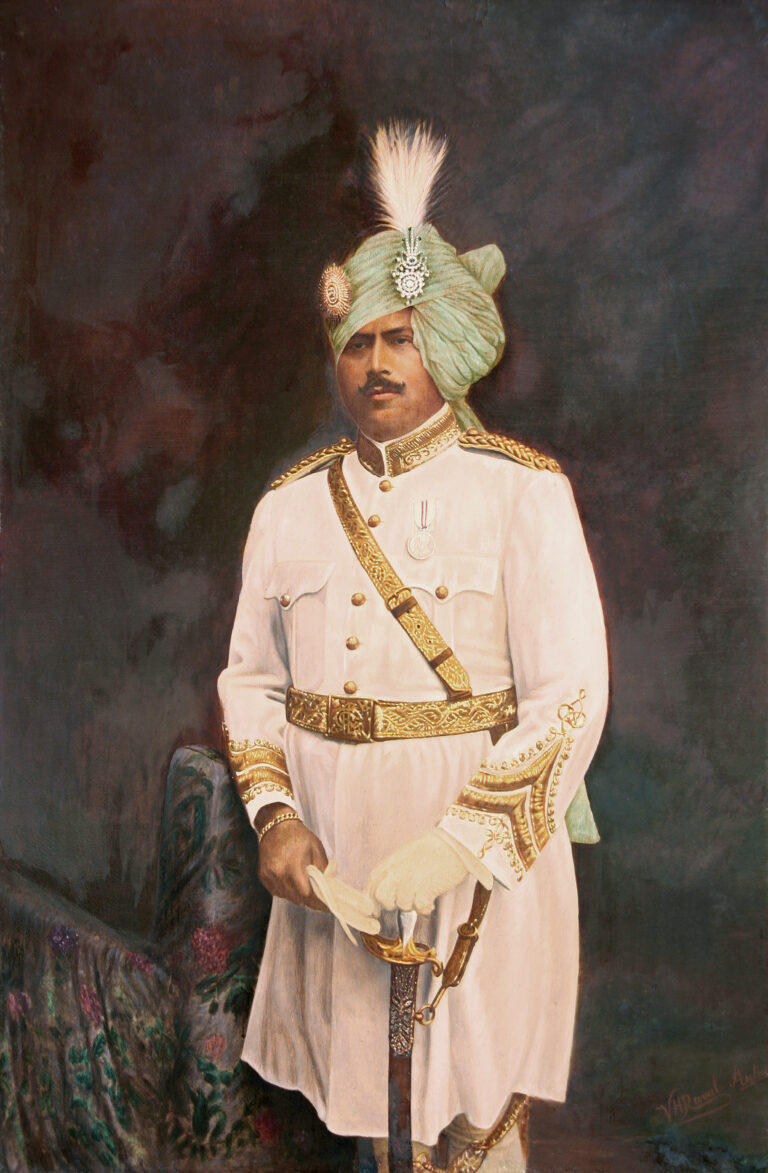Biography
Raja of Nazargunj, Prithi Chand Lal Chaudhuri[1] CBE (Raja P. C. Lall), was born on 7th April, 1886, in Purnea City, Bihar, India.
He was the son of zamindar, Babu Dharam Chand Lal and grandson of Babu Nackched Chand Lal Chaudhuri.
The Raja succeeded his father, the zamindar, Dharam Chand Lal Chaudhuri, at the young age of just thirteen, in March 1899. He was privately educated under the supervision of Cambridge graduate Rev. A. H. Manning.
Head of Purnea Polo Club, the ‘Nazargunj Raj’ Polo team played various matches against the likes of The Berkshire Regiment and other British teams such as The Cameronians[7].
The Raja was the first Indian member of The Calcutta Rackets Club (1936), founded by the British in 1793; one of the oldest squash clubs in the world. He also supported other sports to include horse racing and was a liberal when it came to religion.
Prizes and medals were won for dogs, flowers (e.g. Darjeeling Flower Show) and agriculture. The Raja was proprietor of the annual Purnea city fair and started the Gulab Bagh Fair, which later became one of India’s largest grain trading centres.
A promoter of music, Raja P. C. Lall retained Bismillah Khan (later known as Ustad Bismillah Khan Sahib) during the time of his eldest son’s marriage (Kumar Vishnu Chand Lall, c. 1937) to play shehnai. It was at this time that the young Bismilah Khan was spotted by All India Radio and offered a contract. The Raja granted permission and encouraged him to take up the opportunity.
Raja P. C. Lall was also an honorary magistrate on the Purnea Sudder independent bench and a volunteer in the Northern Bengal Mounted Rifles.
He was acknowledged for ‘valuable services rendered in India in connection with the (World) War up to the 31st December 1918’, Government of Bihar and Orissa.[8]
The Raja was succeeded on 5th February, 1965 by his son, Kumar Vishnu Chand Lall.

Background & Facts
The Nazargunj family were dominant landlords in Purnea but went on to acquire land to include 5 3/4 annas of pargana Surjyapur and 4 annas of pargana Powakhali amongst other smaller properties.[2]
The Raja’s grandfather, Nakched Chand Lal Chaudhuri, was a banker. He acquired Haveli Purnea (pargana Asja, Tauji No.29) from Babu Pratap Singh, for his wife Musamat Bhagwanbati Chaudhrain.
Certain properties were acquired at auction here in 1900, when the Raja was still a minor[3]. Dharampur Estate, also owned by Raja P. C. Lall, within the Kishanganj district, was named after his father, Babu Dharam Chand Lal Chaudhuri, who inherited it from his father (Nakched Chand Lal Chaudhuri) in turn but expanded it significantly. According to O’Malley, the rent-roll was estimated at the time to be nine lakhs, with a revenue demand of over 4 lakhs. [4]
Philanthropy
During his minority, his estate was ably managed by a consortium of trustees, balancing growth and philanthropy. This was very much in line with Mahatma Gandhi’s model of Trusteeship, as documented in Gandhian Economics. The Raja was a great admirer of Gandhi, both before and even more so after entertaining him in Purnea in 1929. The Raja’s grandfather, Nakched Chand Lall Choudhry, also donated (Rs. 80,000) more than half the cost of construction the Sowra bridge[5], connecting the civil station with the old city of Purnea. The Raja built schools (Purnea Zilla School and Rani B.P. Choudhrain School) and temples. He contributed to the likes of the Lady Dufferin Hospital and also the Sadar Charitable Hospital in Purnea. He was an avid champion of improving the local infrastructure and arguing the case for greater investment at a time when there was very little will or support from the authorities[6]. The archives on The Resolution of Ganges-Darjeeling Road (1922) sheds light on this matter. Liberal donations were made by the Raja to The Hardinge Memorial Park at Bankipore as well as the Behar War Fund, in particular for the Motor Ambulance cars.
Racing interest
The Nazargunj family was well known for horse-racing initially in Darjeeling (Novice Stakes in 1911, The Governor’s Cup, 1913 amongst others), in Lucknow (Stewards Cup, 1928), Bangalore (The Philanthropist Cup, 1967, Presented By The Maharaja of Parlakimedi), Hyderabad (Charminar Trophy a.k.a. The Asaf Jah VII Memorial Cup, 1967, presented by HH The Prince of Berar) and also Mysore (The Rajendravilas Palace Trophy, 1983). Most of the prestigious races were won in Calcutta and included The Panagia Davis Cup (1953), The Curlender Cup (1955-56), The Kalinga Cup (1955-56) presented by Maharaja of Parlakimedi, HM The Queen’s Cup (1956-57), The Calcutta Derby (1959–60) presented by the Maharaja of Burdawan, The Gavin Johnston Cup (1969-70) and The Calcutta Oaks (1969-70). Other races won include the Calcutta Monsoon Cup, Indian Gold Vase, The Everynsky Cup, Salisbury Cup, The Republic Cup (1971-72), and The Gurkirpal Cup (1995).
[1] Alternative spelling: “Prithwi Chand Lall Choudhry”
[2] Bengal District Gazetteers Purnea, L.S.S.O’Malley, page 164
[3] Bengal District Gazetteers Purnea, L.S.S.O’Malley, page 202
[4] Bengal District Gazetteers Purnea, L.S.S.O’Malley, page 186
[5] Bengal and Assam, Behar and Orissa,:Their History, People, Commerce, and Industrial Resources, compiled by Somerset Playne, Edited by Arnold Wright, The Foreign & Colonial Compiling and Publishing Co, 27 Pilgrim Street, London (1917)
[6] Resolution Ganges-Darjeeling Road, 26 January, 1922, Page 209. archives.Biharvidhanmandal.in
[7] The Polo Monthly, March 1932, page 398 and The Polo Monthly, March-July 1938, page 113
[8] Extract from The Gazette of India, Extraordinary, July 29th, 1919
[9] Supplement to The London Gazette, 8June, 1944, page 2588
[10] archives.Biharvidhanmandal.in Identifier 373, 29 July 1921














